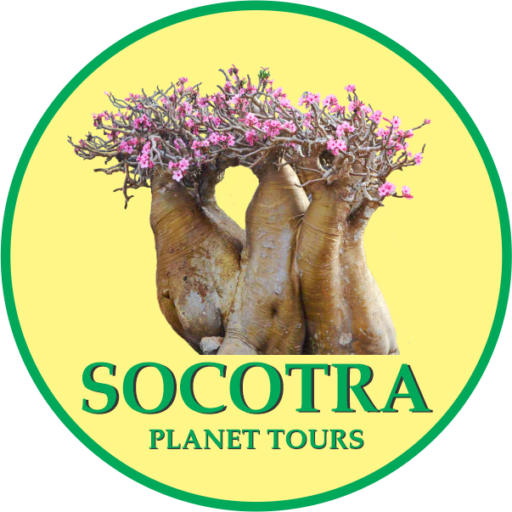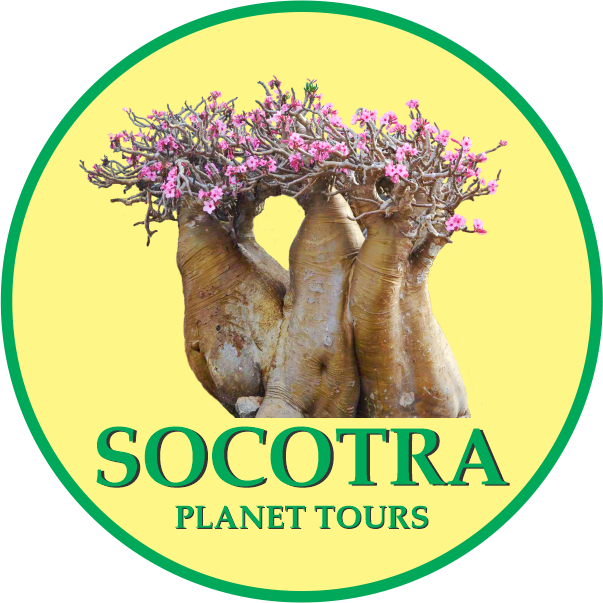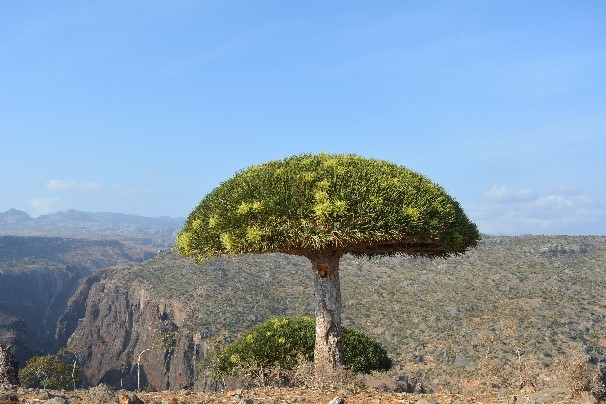Dragon’s Blood Tree Forest: A Jewel of Socotra Island
The Dragon’s Blood Tree Forest in Socotra, Yemen, is one of the most iconic natural landscapes in the world, offering visitors a glimpse into a unique and almost otherworldly ecosystem. Home to the ancient and mysterious Dragon’s Blood Tree (Dracaena cinnabari), this forest stands as a symbol of Socotra’s incredible biodiversity and geological history. In this article, we’ll explore what makes the Dragon’s Blood Tree Forest so special, the ongoing conservation efforts to protect it, and how visitors can experience its beauty through guided tours.
What Makes the Dragon’s Blood Tree Forest Special?
- Unique and Ancient Flora:
The Dragon’s Blood Tree, named for the dark red sap that oozes from its bark, is one of the most remarkable trees on the planet. With its umbrella-like canopy, it is instantly recognizable and contributes to Socotra’s nickname as the “Galápagos of the Indian Ocean.” The tree’s distinctive appearance and the crimson sap have long been a source of intrigue.
The sap, known as “Dragon’s Blood,” has been used for centuries in traditional medicine, dyes, and even cosmetics. Ancient societies prized the resin for its healing properties, using it as a treatment for wounds, ulcers, and as an anti-inflammatory agent. Beyond its historical importance, the Dragon’s Blood Tree is crucial for Socotra’s ecosystem, playing a vital role in preventing soil erosion and providing shade and shelter to smaller plant species.
The forest itself is a relic of a bygone era, representing a unique adaptation to the arid, mountainous conditions of Socotra. Many of the trees in the forest are hundreds, if not thousands, of years old, making it a living time capsule of biodiversity. - Endemic Species The Dragon’s Blood Tree is not the only unique species found in the forest. Socotra is home to hundreds of endemic species, meaning they can be found nowhere else on Earth. In addition to the Dragon’s Blood Tree, the forest contains:
- Socotran Cucumber Tree (Dendrosicyos socotranus): Another strange and distinctive species, it has evolved a water-storing trunk, making it a key player in the island’s desert environment.
- Frankincense Trees (Boswellia socotrana): These trees produce the famous frankincense resin, long valued for religious and cultural rituals.
- Aloe Plants: Several species of Aloe grow throughout the forest, adapted to the harsh desert climate and forming part of the island’s medicinal flora.
The Dragon’s Blood Tree Forest is a critical habitat for Socotra’s wildlife, supporting many rare bird species, reptiles, and invertebrates. Many of these animals depend on the forest for survival, as the unique microclimate under the tree canopies provides cooler temperatures and retains more moisture.
- Cultural and Historical Significance: The Dragon’s Blood Tree holds deep cultural significance for the people of Socotra. The resin has been used for centuries by locals for medicinal and ritualistic purposes. Moreover, the trees are intertwined with the folklore of the island, where many myths speak of their origins and sacredness.
Conservation Efforts: Protecting a Fragile Ecosystem
1. Threats to the Dragon’s Blood Tree Forest
Despite its resilience in surviving for millennia, the Dragon’s Blood Tree Forest faces growing threats from human activity and climate change. Some of the key challenges include:
- Climate Change: Socotra’s increasingly erratic weather patterns are affecting the ability of Dragon’s Blood Trees to reproduce. Prolonged droughts and irregular rainfall hinder the growth of seedlings, limiting natural regeneration.
- Overgrazing: Livestock, especially goats, pose a significant threat to the forest. Grazing animals eat young saplings before they can mature, further diminishing the forest’s ability to sustain itself.
- Deforestation: While large-scale deforestation is not a major issue in Socotra, the slow encroachment of agricultural land and the use of trees for firewood by local communities do pose localized risks to the forest’s health.
2. International and Local Conservation Initiatives
Several conservation programs are actively working to protect the Dragon’s Blood Tree Forest. As a UNESCO World Heritage Site since 2008, Socotra is part of a global effort to preserve its unique ecosystems.
- UNESCO’s Role: As part of its World Heritage designation, Socotra benefits from international recognition and support. UNESCO works with local authorities and international conservation groups to fund preservation projects and provide technical assistance to ensure the island’s ecosystems remain intact.
- Local Conservation Efforts: Local NGOs and community-driven initiatives are critical to the conservation of Socotra’s natural environment. These groups are working to raise awareness among Socotran communities about the importance of sustainable land-use practices, reducing overgrazing, and encouraging reforestation programs.
- Seedling Planting Initiatives: There are programs aimed at collecting Dragon’s Blood seeds and growing them in nurseries for later replanting in the wild. This helps ensure that the species can continue to regenerate despite the pressures it faces.
3. Eco-Tourism as a Tool for Conservation
Tourism, when managed sustainably, can be an essential tool for conservation. Eco-tourism on Socotra is focused on preserving the environment while allowing visitors to experience its wonders. Many guided tours emphasize low-impact travel, encourage visitors to respect the natural environment, and educate travelers about the island’s delicate ecosystems and the importance of conservation.
Revenue from eco-tourism often supports local conservation projects, providing the necessary funds to continue initiatives like tree planting and protecting wildlife.
Guided Tours of the Dragon’s Blood Tree Forest
One of the best ways to explore the Dragon’s Blood Tree Forest is through a guided tour. These tours are led by local experts who provide in-depth knowledge about the island’s ecology, flora, fauna, and cultural history.
1. What to Expect on a Guided Tour
- Expert Guidance: Local guides are typically well-versed in the island’s history, geology, and biodiversity. They will help you understand the ecological significance of the Dragon’s Blood Tree and other plant species.
- Hiking and Trekking: Most tours include light to moderate hikes through the forest, where you can explore different tree clusters, learn about the trees’ role in the ecosystem, and see breathtaking panoramic views of Socotra’s mountains and coastline.
- Wildlife Spotting: As you trek through the forest, you may encounter some of Socotra’s endemic wildlife, including rare bird species like the Socotra Sunbird or the Socotra Starling.
- Cultural Encounters: Some tours include visits to nearby villages where you can meet the indigenous Socotri people, learn about their traditional uses for Dragon’s Blood resin, and gain insight into their way of life.
2. Popular Guided Tour Options
- Half-Day Tours: Ideal for those looking to explore the Dragon’s Blood Tree Forest quickly, these tours typically focus on the main forested areas and provide an introduction to the island’s ecology.
- Full-Day Ecotours: These tours delve deeper into the Dragon’s Blood Tree Forest and may include stops at other significant sites, such as the Diksam Plateau or Homhil Protected Area. Full-day tours often involve longer hikes and provide more time to explore Socotra’s biodiversity.
- Multi-Day Hiking Adventures: For those looking for a more immersive experience, multi-day hiking tours are available. These tours combine exploration of the Dragon’s Blood Tree Forest with other parts of the island, offering camping opportunities and in-depth education about conservation efforts.
The Dragon’s Blood Tree Forest is one of the most extraordinary places on Earth. Its ancient trees, unique ecosystem, and the cultural significance of its iconic Dragon’s Blood resin make it a must-see destination for eco-conscious travelers. While the forest faces threats from climate change and human activities, ongoing conservation efforts and the growth of responsible tourism offer hope for its preservation.
Visiting the Dragon’s Blood Tree Forest through a guided tour not only provides an unforgettable experience but also supports the conservation of this precious natural treasure. By participating in eco-friendly tourism, visitors contribute to preserving the beauty and biodiversity of Socotra for future generations to appreciate.



Comments are closed